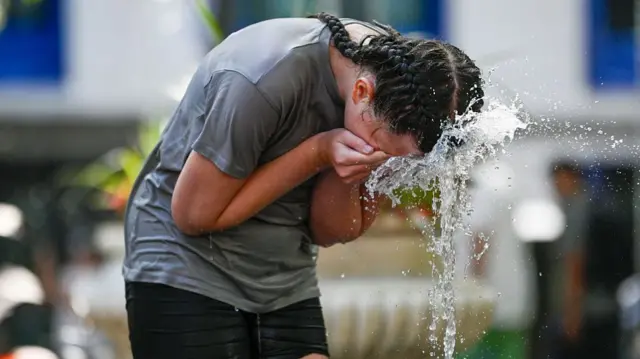England enters fourth heatwave as temperatures reach 33C

London: England has entered its fourth heatwave of the summer, with a number of places seeing temperatures higher than 30C on Tuesday.
Areas in South West England, the South West Midlands, North West England and East Anglia have met heatwave criteria, having had three consecutive days above a certain temperature.
Tuesday’s top temperature of 33.4C was recorded in Northolt in west London, but heatwave conditions were not yet met in the capital or South East England.
After a period of dry, warm weather, England is now suffering from “nationally significant” water shortfalls, the national drought group – which includes the Met Office, regulators, the government and water companies – has warned.
England is suffering widespread environmental effects from the shortage of water, which is hitting farms, damaging wildlife, as well as increasing wildfires, the group said.
Many more areas of the UK, including Wales, Scotland and Northern Ireland, are expected to enter a heatwave on Wednesday, when they surpass a temperature threshold that varies by region for at least three consecutive days.
London and the south-east of England could also enter heatwave territory on Wednesday.
The temperature threshold is highest in London and parts of central England at 28C.
Amber heat health alerts, issued by the UK Health Security Agency (UKHSA), came into effect across the Midlands, East Anglia, London and south-east England on Tuesday morning and continue until 18:00 BST on Wednesday.
Less severe yellow alerts – indicating negative effects on the vulnerable and health services are possible – cover the rest of England until the same time.
Dr Paul Coleman, a consultant in public health at the UKHSA, said there were signs that people were becoming more aware of the dangers of hotter summer weather.
“I think the really reassuring thing is that it does seem to be that people are adapting better to it,” he told the BBC.
“While I think we will see more of it in the future, it seems that people are making the right decisions in protecting themselves from the impacts of hot weather.”
Overheating can lead to heat exhaustion or heatstroke. While the former is less serious, the latter is a medical emergency thar requires immediate treatment.
Older adults, young children and people with long-term health conditions are especially at risk.
a graphic showing the symptoms of heat exhaustion and heatstroke
The cycle of heatwaves has also started to affect rail services, with cancellations and speed restrictions in place on Greater Anglia and South Western services.
The heat and lack of rain has caused the soil under the tracks in some areas of the south of England to shrink, something known as “soil moisture deficit”, making tracks uneven in some places.
Droughts began to occur earlier this summer following a long period of low rainfall and the sixth driest spring since records began in 1836.
Millions of people in England are now under hosepipe bans aimed at limiting water consumption.
While water companies have blamed the heat and lack of rain, they have faced criticism over leaks from the water infrastructure they manage.
The GMB union called Thames Water’s hosepipe ban “disgraceful” given it alone had leaked 200 billion litres of water in the past year.
The hot weather has also been causing challenges for farmers across England as they approach the harvest.
“It looks like this year’s harvest will be catastrophic,” Clarkson’s Farm star Jeremy Clarkson wrote on social media last week. “That should be a worry for anyone who eats food.”
Norfolk had three heatwaves this summer before the latest bout of warm weather, which affected crop yields including wheat and barley.
Farmer Kit Papworth said: “[The] harvest is earlier but yields have been depressed, we just haven’t got the crop that we normally would have.”
Martin Williams, a third-generation arable farmer in Herefordshire, said 2025 could be a write-off for his crop.
“It’s burnt to brown, it looks like toast. It’s all straggly and dead, and it’s not really good for much at all.”
Meanwhile, National Farmers Union vice-president Rachel Hallo warned that water was a precious resource and “absolutely vital to producing the food our country needs”.
“Now’s the time to start having open and honest conversations and treating water as a national strategic priority”, she said at a summit on Monday.
Map of UK and central Europe showing red colours and wind arrows coming from the south across the British Isles
The UK has been drawing in some very warm air from Europe, where temperatures have been particularly high
While linking climate change with specific individual extreme weather events can be difficult, scientists say that climate change is generally making heatwaves hotter, longer and more frequent.
Sir David King, Chair of the Global Climate Crisis Advisory Group and a former chief scientific adviser to the government, told the BBC that drought conditions in England were “a clear signal that climate collapse is unravelling our water, food and natural systems”.
“This crisis demands a fundamental shift that places real value on our planet and environment, invests in nature, restores water cycles and transforms how we use every drop [of water]”, he said.
There have been 13 days so far this year that have seen temperatures in excess of 30C in the UK.
That number will rise further this week, but is still less than the 19 days in 2022 and 34 days in 1995.
The Met Office has had its heatwave criteria only for a few years and there is no official list of heatwaves before that time.
Temperature thresholds might have been lower in previous decades so it is not possible to give a definitive number of heatwaves per year.
However, very warm summers like 2018 and 1995 are likely to have seen at least four heatwaves like this year.





